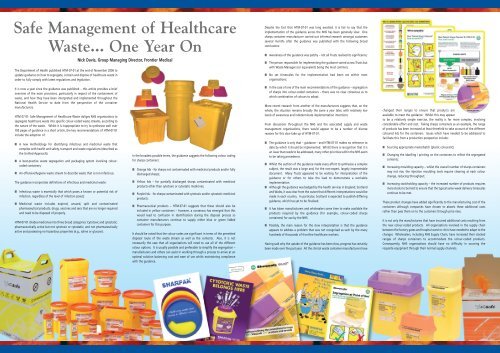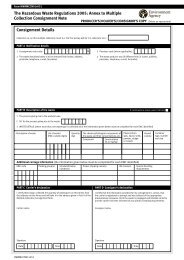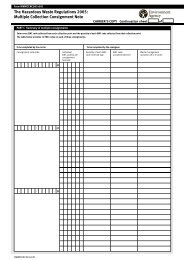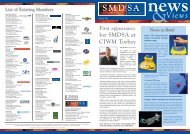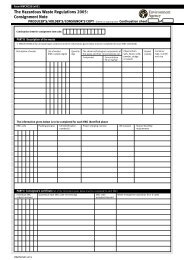&Views
Views - SMDSA
Views - SMDSA
- No tags were found...
You also want an ePaper? Increase the reach of your titles
YUMPU automatically turns print PDFs into web optimized ePapers that Google loves.
Safe Management of Healthcare<br />
Waste... One Year On<br />
The Department of Health published HTM-07-01 at the end of November 2006 to<br />
update guidance on how to segregate, contain and dispose of healthcare waste in<br />
order to fully comply with latest regulations and legislation.<br />
Nick Davis, Group Managing Director, Frontier Medical<br />
Despite the fact that HTM-07-01 was long awaited, it is fair to say that the<br />
implementation of the guidance across the NHS has been generally slow. One<br />
sharps container manufacturer carried out informal research amongst customers<br />
several months after the guidance was published with the following broad<br />
conclusions:<br />
■<br />
■<br />
■<br />
Awareness of the guidance was patchy – not all Trusts realised its significance;<br />
The person responsible for implementing the guidance varied across Trusts but<br />
with Waste Managers (or equivalent) being the most common;<br />
No set timescales for the implementation had been set within most<br />
organisations;<br />
It is now a year since the guidance was published – this article provides a brief<br />
overview of the main provisions, particularly in respect of the containment of<br />
waste, and how they have been interpreted and implemented throughout the<br />
National Health Service to date from the perspective of the container<br />
manufacturers.<br />
HTM 07-01: Safe Management of Healthcare Waste obliges NHS organisations to<br />
segregate healthcare waste into specific colour-coded waste streams, according to<br />
the nature of the waste. Whilst it is inappropriate to try to synthesise well over<br />
100 pages of guidance in a short article, the key recommendations of HTM-07-01<br />
include the adoption of:<br />
■<br />
■<br />
■<br />
A new methodology for identifying infectious and medicinal waste that<br />
complies with health and safety, transport and waste regulations (described as<br />
the Unified Approach);<br />
A best-practice waste segregation and packaging system involving colourcoded<br />
containers;<br />
An offensive/hygiene waste stream to describe waste that is non-infectious.<br />
The guidance incorporates definitions of infectious and medicinal waste:<br />
■<br />
■<br />
Infectious waste is essentially that which poses a known or potential risk of<br />
infection, regardless of the level of infection posed;<br />
Medicinal waste includes expired, unused, spilt and contaminated<br />
pharmaceutical products, drugs, vaccines and sera that are no longer required<br />
and need to be disposed of properly.<br />
HTM-07-01 divides medicines into three broad categories: Cytotoxic and cytostatic;<br />
pharmaceutically active but not cytotoxic or cytostatic; and not pharmaceutically<br />
active and possessing no hazardous properties (e.g., saline or glucose).<br />
In the broadest possible terms, the guidance suggests the following colour coding<br />
for sharps containers:<br />
■<br />
■<br />
■<br />
■<br />
Orange lids - for sharps not contaminated with medicinal products and/or fully<br />
discharged sharps;<br />
Yellow lids – for partially discharged sharps contaminated with medicinal<br />
products other than cytotoxic or cytostatic medicines;<br />
Purple lids - for sharps contaminated with cytotoxic and/or cytostatic medicinal<br />
products.<br />
Pharmaceutical products – HTM-07-01 suggests that these should also be<br />
included in yellow containers – however, a consensus has emerged that this<br />
would lead to confusion in identification during the disposal process so<br />
container manufacturers continue to supply either blue or green lidded<br />
containers for this purpose.<br />
It should be noted that the colour-codes are significant in terms of the permitted<br />
disposal route of the waste stream as well as the contents. Also, it is not<br />
necessarily the case that all organisations will need to use all of the different<br />
colour options. It is usually possible and preferable to simplify the segregation –<br />
manufacturers and others can assist in working through a process to arrive at an<br />
optimal solution balancing cost and ease of use whilst maintaining compliance<br />
with the guidance.<br />
■<br />
In the case of one of the main recommendations of the guidance – segregation<br />
of sharps into colour-coded containers – there was no clear consensus as to<br />
which combination of colours to adopt.<br />
More recent research from another of the manufacturers suggests that, on the<br />
whole, the situation remains broadly the same a year later, with relatively low<br />
levels of awareness and indeterminate implementation intentions<br />
From discussions throughout the NHS and the associated supply and waste<br />
management organisations, there would appear to be a number of diverse<br />
reasons for this slow take up of HTM-07-01:<br />
■<br />
■<br />
■<br />
■<br />
■<br />
The guidance is only that – guidance – and HTM-07-01 makes no reference to<br />
date by which it should be implemented. Whilst there is recognition that it is<br />
an issue that needs to be addressed, many other priorities within the NHS seem<br />
to be taking precedence.<br />
Whilst the authors of the guidance made every effort to synthesise a complex<br />
subject, the result was a large and, for the non-expert, largely impenetrable<br />
document. Many Trusts appeared to be waiting for interpretation of the<br />
guidance or for others to take the lead to demonstrate a workable<br />
implementation.<br />
Although the guidance was badged by the health services in England, Scotland<br />
and Wales, it was clear from the outset that different interpretations would be<br />
made in each country. In particular, Scotland is expected to publish differing<br />
guidance, which has yet to be finalised.<br />
It has taken manufacturers and wholesalers some time to make available the<br />
products required by the guidance (for example, colour-coded sharps<br />
containers) for use by the NHS.<br />
Possibly, the main reason for the slow interpretation is that the guidance<br />
appears to address a problem that was not recognised as such by the many<br />
hundreds of thousands of frontline healthcare workers.<br />
Having said why the uptake of the guidance has been slow, progress has certainly<br />
been made over the past year. All the clinical waste container manufacturers have<br />
changed their ranges to ensure that products are<br />
available to meet the guidance. Whilst this may appear<br />
to be a relatively simple exercise, the reality is far more complex, involving<br />
considerable effort and cost. Taking sharps containers as an example, the range<br />
of products has been increased at least threefold to take account of the different<br />
coloured lids for the containers. Issues which have needed to be addressed to<br />
facilitate this from a production perspective include:<br />
■<br />
■<br />
■<br />
■<br />
Sourcing appropriate masterbatch (plastic colourant);<br />
Changing the labelling / printing on the containers to reflect the segregated<br />
contents;<br />
Increasing moulding capacity – whilst the overall number of sharps containers<br />
may not rise, the injection moulding tools require cleaning at each colour<br />
change, reducing throughput;<br />
Increasing stockholding capacity – the increased number of products requires<br />
more stocks to be held to ensure that the typical same-week delivery timescales<br />
continue to be met.<br />
These product changes have added significantly to the manufacturing cost of the<br />
containers although companies have chosen to absorb these additional costs<br />
rather than pass them on to the customers through price rises.<br />
It is not only the manufacturers that have incurred additional costs resulting from<br />
the new colour-coded products. All organisations involved in the supply chain<br />
between the factory gates and hospital ward or clinic have needed to adapt to the<br />
changes. Wholesalers, including NHS Supply Chain, have increased their stocked<br />
ranges of sharps containers to accommodate the colour-coded products.<br />
Consequently, NHS organisations should have no difficulty in sourcing the<br />
requisite equipment through their normal supply channels.


